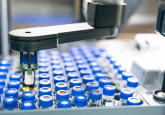Probe in development could revolutionize how scientists study the brain

A tiny wire in development could speed up the discovery of drugs for little-understood diseases of the brain, such as Alzheimer’s disease or Lou Gehrig’s disease. A team led by Janusz Pawliszyn from the University of Waterloo (Canada) along with researchers from Concordia University (Canada) and the Centre for Addiction and Mental Health (Canada), are building on Pawliszyn’s earlier research to develop a brain probe suitable for use on live subjects.
The probe design aims to reduce the cost, time, and risks associated with development of neurologic drugs, while helping researchers to better understand the causes of degenerative brain disease. It is hoped that this, in turn, will provide insights into how best to treat these conditions.
The wire probe is 0.1 mm wide—less than the width of a human hair—and designed to be inserted directly into the brain at multiple depths. Researchers are then able to analyze the coating of the probe to obtain a full chemical profile of the brain, including lipid concentrations, neurotransmitters, drug levels and their metabolites.
“Chemistry is extremely important when it comes to the brain,” said Pawliszyn. “While MRIs can track physical changes in the brain and tissues, it can’t track the chemistry largely responsible for brain functioning and behavior. If we can build a solid chemical profile of the brain it will allow us to better understand which drugs are working the way we expect and which aren’t when attempting to find treatments for ALS [Lou Gehrig’s disease] or Alzheimer’s.”
The method is based on solid-phase microextraction, a technique developed by Pawliszyn that uses a solid coating on a sampling probe to selectively extract chemical substances. Pawliszyn has used this technology to develop other medical sampling methods, including a method to detect melanoma and skin disorders and improved methods to detect athletic doping drugs in blood, saliva and urine.
The new project aims to address one of the major challenges faced by the pharmaceutical industry, which is the need to decrease the number of animals used in the drug discovery process. As no tissue or fluids are withdrawn, fewer laboratory animals are necessary for research. Researchers believe that the technique may eventually be safe to use on live human patients.
Source: Waterloo chemist to develop revolutionary new probe to study the brain.




